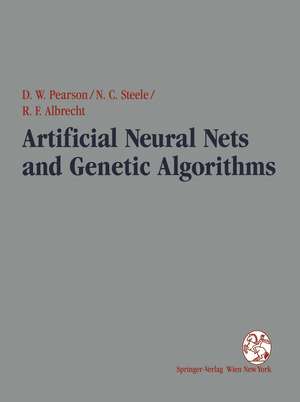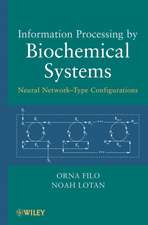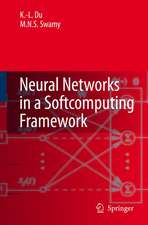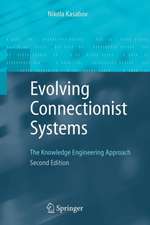Artificial Neural Nets and Genetic Algorithms: Proceedings of the International Conference in Alès, France, 1995
Autor David W. Pearson, Nigel C. Steele, Rudolf F. Albrechten Limba Engleză Paperback – 4 apr 1995
Preț: 361.44 lei
Preț vechi: 451.80 lei
-20% Nou
Puncte Express: 542
Preț estimativ în valută:
69.16€ • 72.21$ • 57.24£
69.16€ • 72.21$ • 57.24£
Carte tipărită la comandă
Livrare economică 04-18 aprilie
Preluare comenzi: 021 569.72.76
Specificații
ISBN-13: 9783211826928
ISBN-10: 3211826920
Pagini: 548
Ilustrații: XV, 522 p. 339 illus.
Dimensiuni: 210 x 279 x 29 mm
Greutate: 1.22 kg
Ediția:Softcover reprint of the original 1st ed. 1995
Editura: SPRINGER VIENNA
Colecția Springer
Locul publicării:Vienna, Austria
ISBN-10: 3211826920
Pagini: 548
Ilustrații: XV, 522 p. 339 illus.
Dimensiuni: 210 x 279 x 29 mm
Greutate: 1.22 kg
Ediția:Softcover reprint of the original 1st ed. 1995
Editura: SPRINGER VIENNA
Colecția Springer
Locul publicării:Vienna, Austria
Public țintă
ResearchDescriere
Artificial neural networks and genetic algorithms both are areas of research which have their origins in mathematical models constructed in order to gain understanding of important natural processes. By focussing on the process models rather than the processes themselves, significant new computational techniques have evolved which have found application in a large number of diverse fields. This diversity is reflected in the topics which are subjects of the contributions to this volume.There are contributions reporting successful applications of the technology to the solution of industrial/commercial problems. This may well reflect the maturity of the technology, notably in the sense that 'real' users of modelling/prediction techniques are prepared to accept neural networks as a valid paradigm. Theoretical issues also receive attention, notably in connection with the radial basis function neural network. Contributions in the field of genetic algorithms reflect the wide range of current applications, including, for example, portfolio selection, filter design, frequency assignment, tuning of nonlinear PID controllers. These techniques are also used extensively for combinatorial optimisation problems.
Cuprins
Workshop Summary.- Invited Talk.- Kohonen neural networks for machine and process condition monitoring.- Plenary Session.- Process modelling and control with neural networks: present status and future directions.- Session A1: Classification.- A genetic algorithm for multicriteria inventory classification.- Optimizing classifiers for handwritten digits by genetic algorithms.- DCS: A promising classifier system.- Application of neural networks for classification of temperature distribution patterns.- Session B1: Genetic Algorithms and Combinatorial Optimisation.- Combination of genetic algorithms and CLP in the vehicle-fleet scheduling problem.- Minimum cost topology optimisation of the COST 239 European optical network.- Timetabling using genetic algorithms.- Resolution of cartographic layout problem by means of improved genetic algorithms.- Using genetic algorithms to solve the radio link frequency assignment problem.- Session C1: Learning and Training.- A transformation for implementing efficient dynamic backpropagation neural networks.- AA1*: a dynamic incremental network that learns by discrimination.- Non-supervised sensory-motor agents learning.- Functional equivalence and genetic learning of RBF networks.- Teaching relaxation labeling processes using genetic algorithms.- VLSI optimal neural network learning algorithm.- Session A2: Applications in Biology and Biotechnology.- Using of neural-network and expert-system for imissions prediction.- The costing of process vessels using neural networks.- Neural network modelling of fermentation taking into account culture memory.- Brain electrographic state detection using combined unsupervised and supervised neural networks.- Session B2: Genetic and Neural Theory Combined.- From the chromosome to the neural network.- CAM-Brain: the evolutionary engineering of a billion neuron artificial brain by 2001 which grows/evolves at electronic speeds inside a cellular automata machine (CAM).- A perfect integration of neural networks and evolutionary algorithms.- G-LVQ, a combination of genetic algorithms and LVQ.- Evolving neural network structures: an evaluation of encoding techniques.- Session C2: Failure Detection and Identification.- Application of radial basis function networks to fault diagnosis for a hydraulic system.- Optimally robust fault diagnosis using genetic algorithms.- Development of a neural-based diagnostic system to control the ropes of mining shifts.- Lime kiln fault detection and diagnosis by neural networks.- Investigations into the use of wavelet transformations as input into neural networks for condition monitoring.- Session A3: Image, Motion and Recognition.- Genetic algorithm for neurocomputer image recognition.- Feature map architectures for pattern recognition: techniques for automatic region selection.- Adaptive genetic algorithms for multi-point path finding in artificial potential fields.- Spatio-temporal mask learning: application to speech recognition.- Artificial neural networks for motion estimation.- Advanced neural networks methods for recognition of handwritten characters.- Session B3: Genetic Algorithms Theory.- The use of a variable length chromosome for permutation manipulation in genetic algorithms.- Theoretical bounds for genetic algorithms.- An argument against the principle of minimum alphabet.- Heterogeneous co-evolving parasites.- Typology of boolean functions using Walsh analysis.- Session C3: Neural Networks Theory.- Artificial neural networks for nonlinear projection and exploratory data analysis.- Generic back-propagation in arbitrary feedforward neural networks.- From prime implicants to modular feedforward networks.- Hierarchical backward search method: a new classification tree using preprocessing by multilayer neural network.- Adaptation algorithms for 2-D feedforward neural networks.- Selecting the best significant fragment to the incremental heteroassociative neural network (RHI).- Session A4: Image, Motion and Recognition.- An orthogonal neural network with guaranteed recall by iterative filters and its application to texture discrimination.- Automatic radar target identification using neural networks.- Keystroke dynamics based user authentication using neural networks.- Application of learning to learn to real-world pattern recognition.- Quarry aggregates: a flexible inspection method utilising artificial neural networks.- Session B4: Genetic Algorithms Theory.- An evolution model for integration problems.- Convergence of algorithm and the schema theorem in genetic algorithms.- Incorporating neighbourhood search operators into genetic algorithms.- Automatic change of representation in genetic algorithms.- Dominant takeover regimes for genetic algorithms.- Interactive evolutionary algorithms in design.- Session C4: Neural Networks Theory.- Decrypting neural network data: a GIS case study.- A framework for creating societies of agents.- Adaptive scaling of codebook vectors.- Bias estimation for neural network predictions.- ANN realizations of local approximation schemes.- Changing network weights by Lie groups.- Session A5: Time Series, Sequences and Filters.- Unsupervised learning of temporal sequences by neural networks.- Multivariate time series modeling of financial markets with artificial neural networks.- Neural network approach to Pisarenko’s frequency estimation.- Rounding FIR filter coefficients using genetic algorithms.- Evolutionary adaptive filtering.- Session B5: Genetic Algorithms and Combinatorial Optimisation.- A genetic algorithm for some discrete-continuous scheduling problems.- Hybridizing genetic algorithms with branch and bound techniques for the resolution of the TSP.- Performance of genetic algorithm used for analysis of call and service processing in telecommunications.- Evolutionary heuristics for the bin packing problem.- A clausal genetic representation and its evolutionary procedures for satisfiability problems.- Session C5: Parallelism and Neural Networks.- Massively parallel training of multi layer perceptrons with irregular topologies.- Parallel Boltzmann machine topologies for simulated annealing realisation of combinatorial problems.- Radial Basis Function Networks.- Radial basis function neural networks in credit application vetting systems.- A dynamical architecture for a radial basis function network.- Centre selection for radial basis function networks.- Session A6: Multimedia, CAD and Software Tools.- Flexible user-guidance in multimedia CBT-applications using artificial neural networks.- Use of genetic and neural technologies in oil equipment computer-aided design.- GENESIS: an object-oriented framework for simulation of neural network models.- NNDT — a neural network development tool.- Session B6: Genetic and Neural Theory Combined.- Genetic synthesis of task-oriented neural networks.- Evolving neural networks using the “Baldwin effect”.- Genetic Algorithms Theory.- Modification of Holland’s reproductive plan for diploid populations.- Session C6: Optimisation.- Simulated annealing artificial neural networks for the satisfiability (SAT) problem.- Policy optimization by neural network and its application to queueing allocation problem.- Comparison of genetic and other unconstrained optimization methods.- Neural networks for dynamical crop growth model reduction and optimization.- Session A7: Self-Organizing Maps and Auto-Associative Memory.- Modified Kohonen’s learning laws for RBF network.- Kohonen’s maps for contour and “region-like” segmentation of gray level and color images.- Using genetic algorithm in self-organizing map design.- Modular labeling RAAM.- Self-organizing maps for supervision in robot pick-and-place operations.- Session B7: Parallelism and Genetic Algorithms.- Q-Learning and parallelism in evolutionary rule based systems.- Comparing parallel tabu search and parallel genetic algorithms on the task allocation problem.- Distributed genetic algorithms with an application to portfolio selection problems..- Optimisation.- Interval arithmetic and genetic algorithms in global optimization.- A genetic algorithm for minimization of fixed polarity Reed-Muller expressions.- Session C7: Control Theory Applications.- Identification and adaptive control of nonlinear processes using combined neural networks and genetic algorithms.- Elevator group control using distributed genetic algorithms.- Neural control of nonlinear non-minimum phase dynamical systems.- Industrial kiln multivariable control: MNN and RBFNN approaches.- Genetic tuning of neural non-linear PID controllers.- Session A8: Applications in Biology and Biotechnology.- Connectionist algorithm for a 3D dense image building from stereoscopy.- A unified neural network model for the self-organization of topographic receptive fields and lateral interaction.- A neural network implementation for an electronic nose.- Genetic algorithms (GAs) in the role of intelligent regional adaptation agents for agricultural decision support systems.- Genetic algorithm applied to radiotherapy treatment planning.- Session B8: Learning and Training.- An experience based competitive learning neural model for data compression.- Using neural networks for generic strategic planning.- Neural network training compared for backprop, quickprop and cascor in energy control problems.- Session C8: Mixed Applications.- Application of neural network for home security system.- Application of genetic algorithms in sliding mode control design.- Application of temporal neural networks to source localisation.- Using genetic algorithms for optimal design of axially loaded non-prismatic columns.- Behaviour learning by a reward-penalty algorithm: from gait learning to obstacle avoidance by neural networks.- Session A9: Training Data Selection.- Using evolutionary computation to generate training set data for neural networks.- Optimal training pattern selection using a cluster-generating artificial neural network.- Training set selection in neural network applications.- Session B9: Parallelism and Genetic Algorithms.- A genetic algorithm for load balancing in parallel query evaluation for deductive relational databases.- Combining distributed populations and periodic centralized selections in coarse-grain parallel genetic algorithms.- Modified genetic algorithms by efficient unification with simulated annealing.- VLSI standard-cell placement by parallel hybrid simulated-annealing and genetic algorithm.- Genetic Algorithms and Combinatorial Optimisation.- Performance of genetic algorithms in the solution of permutation flowshop problems.- A genetic algorithm for the maximal clique problem.- Session C9: Fuzzy Logic and Uncertainty.- Minimal error rate classification in a non-stationary environment via a modified fuzzy ARTMAP network.- Decision making in uncertain environment with genetic algorithms.- The use of fuzzy ARTMAP to identify low risk coronary care patients.- NeuroGraph — a simulation environment for neural networks, genetic algorithms and fuzzy logic.- Time Series, Sequences and Filters.- Comparison of identification techniques for nonlinear systems.

























